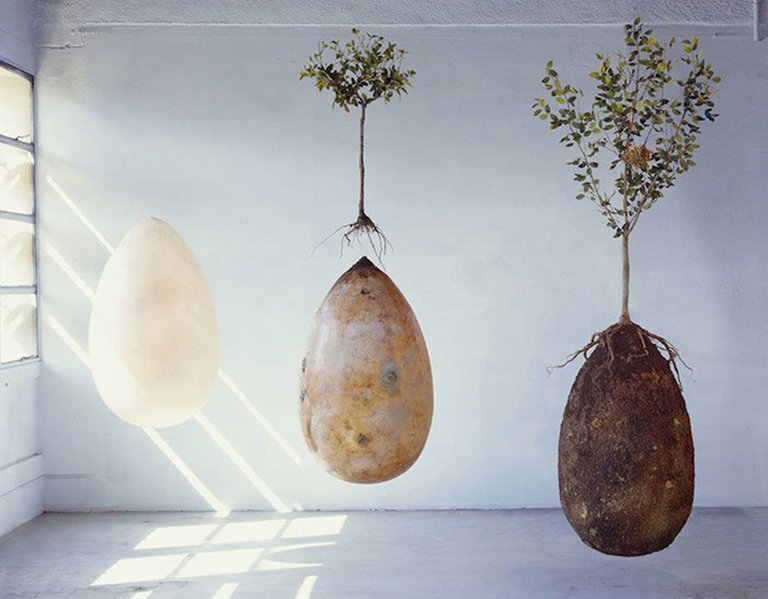Capsula Mundi
Hace relativamente poco mi anciana madre me comentó su deseo de ser incinerada a su muerte y me pidió que sus cenizas fueran esparcidas en determinada zona cercana a la población en la que reside. Parece algo lógico y trivial plantearse que cuando muramos van a enterrar nuestro cadáver o bien va a ser incinerado. Realmente no nos planteamos nada más y parece que cultural y sociológicamente lo asumimos.
Aunque en la antigüedad el ser humano enterraba a sus difuntos directamente en la tierra, ya existen datos de que civilizaciones como la sumeria o la egipcia, miles de años antes de Cristo utilizaban cajas de madera o sarcófagos como método de enterramiento, seguramente debido a un componente religioso muy arraigado.
En Europa es a partir del siglo XVII cuando la práctica de utilizar ataudes y el consiguiente negocio que ello genera comienza a popularizarse y permanece en vigor hoy en día a pesar de que cada vez está más extendida la idea de la incineración.
Independientemente de creencias religiosas o no es un hecho que hay que hacer algo con los cadáveres y parece que o bien incinerarlos o bien enterrarlos y meterlos en nichos y panteones parece lo más razonable. Pero tanto para incinerar un cadáver como para enterrarlo es necesario la utilización de un ataúd, lo que implica talar árboles y utilizar la madera para su construcción. Y también es necesario utilizar terrenos, cada vez más escasos donde construir los cementerios.
Relatively recently my elderly mother told me of her wish to be cremated at her death and asked me to have her ashes scattered in a certain area near the town where she lives. It seems logical and trivial to consider whether our body will be buried or cremated when we die. We don't really think about anything else and it seems that culturally and sociologically we assume it.
Although in ancient times humans buried their dead directly in the ground, there is already evidence that civilisations such as the Sumerian or Egyptian, thousands of years before Christ, used wooden boxes or sarcophagi as a method of burial, probably due to a deeply rooted religious component.
In Europe, it was from the 17th century onwards that the practice of using coffins and the resulting business that this generated began to become popular and remains in force today, despite the fact that the idea of cremation is becoming more and more widespread.
Regardless of religious beliefs or not, it is a fact that something has to be done with corpses and it seems that either cremating them or burying them and putting them in niches and pantheons seems the most reasonable thing to do. But both cremation and burial require the use of a coffin, which means cutting down trees and using wood for the construction of the coffin. And it is also necessary to use increasingly scarce land on which to build cemeteries.

Pero ¿y si existiese otra alternativa? Pues si, la hay. Se trata del proyecto Capsula Mundi creado por dos diseñadores italianos consistente básicamente en un entierro ecológico y orgánico, un entierro en el que no se utilizan ataudes y que contribuye al desarrollo sostenible de nuestro planeta.
El proyecto Capsula Mundi consiste en utilizar una especie de cápsula fabricada con un material ecológico proveniente del almidón de las plantas. La cápsula tiene forma de huevo, similar a una placenta y el cadáver se introduce en posición fetal para posteriormente ser enterrado bajo un árbol o semillas de árbol. La cápsula al ser biodegradable se descompondrá junto a los restos del fallecido convirtiéndose todo ello en un sustrato orgánico que servirá de nutrientes para el árbol.
De esa forma los cementerios se sustituirían por bosques de árboles en el que los familiares y amigos puedan recordar a sus difuntos en un entorno natural lleno de paz y tranquilidad. Se evita la tala de árboles y se fomenta plantar otros nuevos.
But what if there were another alternative? Yes, there is. This is the Capsula Mundi project created by two Italian designers, which basically consists of an ecological and organic burial, a burial in which no coffins are used and which contributes to the sustainable development of our planet.
The Capsula Mundi project consists of using a kind of capsule made from an ecological material derived from plant starch.. The capsule is shaped like an egg, similar to a placenta, and the corpse is introduced in the foetal position and then buried under a tree or tree seed. As the capsule is biodegradable, it will decompose together with the remains of the deceased and become an organic substrate that will serve as nutrients for the tree.
In this way, cemeteries would be replaced by forests of trees in which family and friends can remember their deceased in a natural environment full of peace and tranquillity. It prevents the felling of trees and encourages the planting of new ones.


Este proyecto es simplemente eso, un proyecto. En Italia las autoridades no lo han autorizado ya que su legislación prohíbe el entierro fuera de cementerios pero abre un debate interesante. Seguramente habrá muchas personas horrorizadas con esta idea, pero al mismo tiempo ofrecerá una alternativa satisfactoria a otras muchas.
¿Y tú que opinas? ¿Te agradaría la idea de ser enterrado de esta manera a tu muerte?
This project is just that, a project. In Italy the authorities have not authorised it as their legislation prohibits burial outside cemeteries, but it opens up an interesting debate. Many people will probably be horrified by this idea, but at the same time it will offer a satisfactory alternative to many others.
What do you think, would you like the idea of being buried in this way at your death?
Referencias:
https://ecoinventos.com/capsulamundi/
http://www.redfuneraria.com/sector-funerario/productos-novedosos/capsula-mundi-una-nueva-despedida-ecologica
https://www.ecoportal.net/temas-especiales/cambio-climatico/capsula-mundi-continuidad-del-ciclo-de-la-vida/
https://www.experimenta.es/noticias/industrial/capsula-mundi-arbol-vida-raoul-bretzel-anna-citelli/
https://curiosfera-historia.com/historia-del-ataud/
